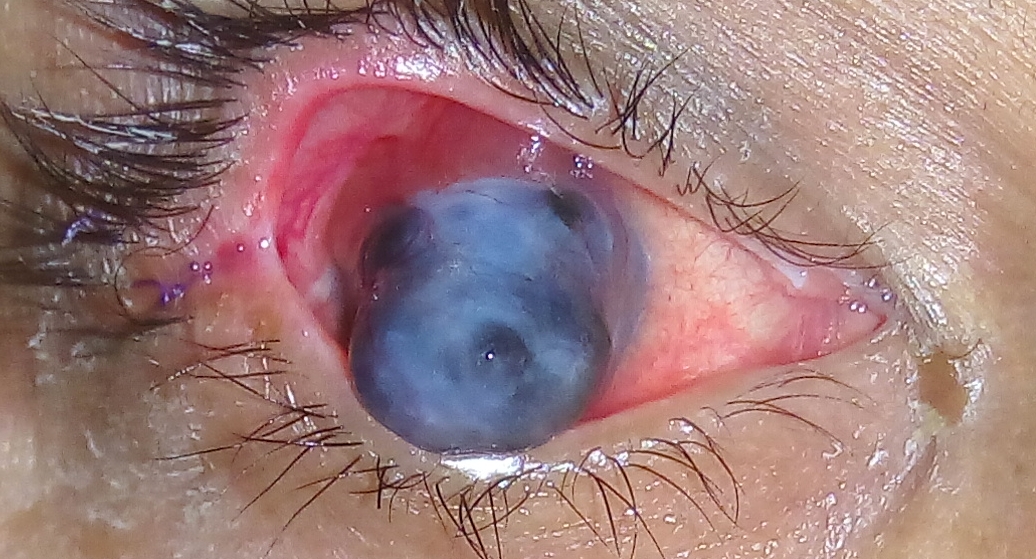staphyloma on:
[Wikipedia]
[Google]
[Amazon]
A staphyloma is an abnormal protrusion of the uveal tissue through a weak point in the eyeball. The protrusion is generally black in colour, due to the inner layers of the eye. It occurs due to weakening of outer layer of eye (cornea or sclera) by an inflammatory or degenerative condition.
It may be of five types, depending on the location on the eyeball (''bulbus oculi'').
 In the anterior segment of the eye, involving the cornea and the nearby
In the anterior segment of the eye, involving the cornea and the nearby
 As the name implies, it is the bulge of weak sclera lined by ciliary body, which occurs about 2–3 mm away from the limbus. Its common causes are thinning of sclera following perforating injury, scleritis & absolute glaucoma.
It is a part of anterior staphyloma.
As the name implies, it is the bulge of weak sclera lined by ciliary body, which occurs about 2–3 mm away from the limbus. Its common causes are thinning of sclera following perforating injury, scleritis & absolute glaucoma.
It is a part of anterior staphyloma.
 In the posterior segment of the eye, typically diagnosed at the region of the optic nerve or macula, deforming the eye in a way that the eye-length is extended associated with
In the posterior segment of the eye, typically diagnosed at the region of the optic nerve or macula, deforming the eye in a way that the eye-length is extended associated with
Anterior (corneal) staphyloma
 In the anterior segment of the eye, involving the cornea and the nearby
In the anterior segment of the eye, involving the cornea and the nearby sclera
The sclera, also known as the white of the eye or, in older literature, as the tunica albuginea oculi, is the opaque, fibrous, protective, outer layer of the human eye containing mainly collagen and some crucial elastic fiber. In humans, and som ...
. It is an ectasia of pseudocornea ( the scar formed from organised exudates and fibrous tissue covered with epithelium) which results after sloughing of cornea with iris plastered behind, it is known as anterior staphyloma.
Intercalary staphyloma
It is the name given to the localised bulge in limbal area, lined by the root of the iris. It results due to ectasia of weak scar tissue formed at the limbus, following healing of a perforating injury or a peripheral corneal ulcer. There may be associated secondary angle closure glaucoma, may cause progression of the bulge if not treated. Defective vision occurs due to marked corneal astigmatism. Treatment consists of localised staphylectomy under heavy doses of oral steroids.Ciliary staphyloma
 As the name implies, it is the bulge of weak sclera lined by ciliary body, which occurs about 2–3 mm away from the limbus. Its common causes are thinning of sclera following perforating injury, scleritis & absolute glaucoma.
It is a part of anterior staphyloma.
As the name implies, it is the bulge of weak sclera lined by ciliary body, which occurs about 2–3 mm away from the limbus. Its common causes are thinning of sclera following perforating injury, scleritis & absolute glaucoma.
It is a part of anterior staphyloma.
Equatorial staphyloma
On the equator of the eye (region circumferencing the largest diameter orthogonal to the visual axis). Its causes are scleritis & degeneration of sclera in pathological myopia. It occurs more commonly in the regions of sclera which are perforated by vortex veins.Posterior staphyloma
 In the posterior segment of the eye, typically diagnosed at the region of the optic nerve or macula, deforming the eye in a way that the eye-length is extended associated with
In the posterior segment of the eye, typically diagnosed at the region of the optic nerve or macula, deforming the eye in a way that the eye-length is extended associated with myopia
Near-sightedness, also known as myopia and short-sightedness, is an eye disease where light focuses in front of, instead of on, the retina. As a result, distant objects appear blurry while close objects appear normal. Other symptoms may include ...
(nearsightedness). It is diagnosed by ophthalmoscopy, which shows an area of retinal excavation in the region of the staphyloma.
References
{{Medicine Eye diseases